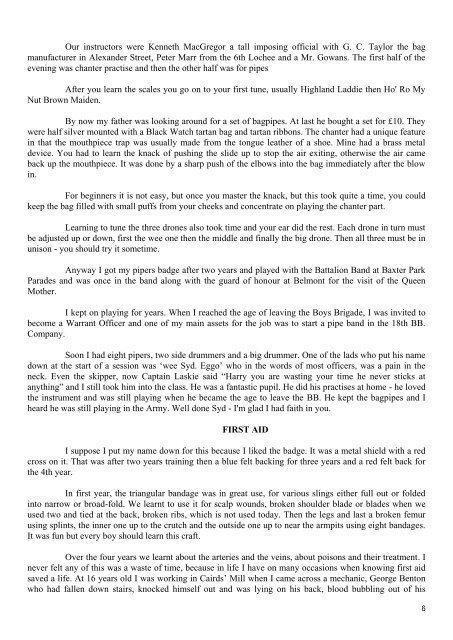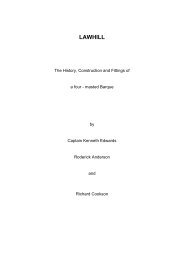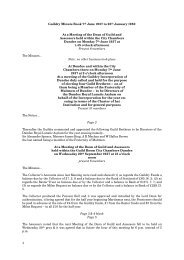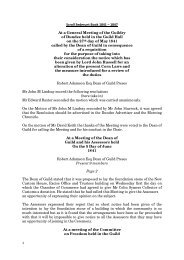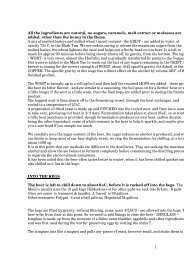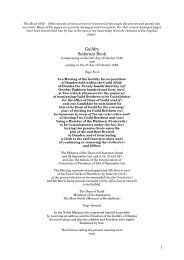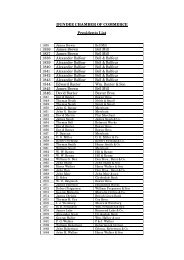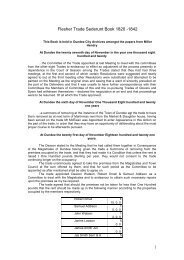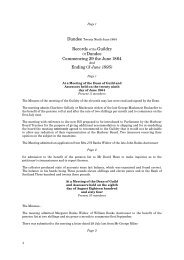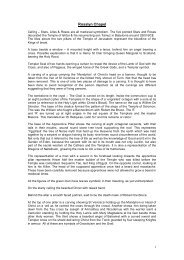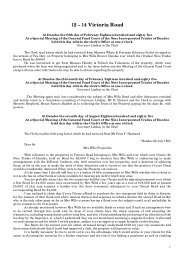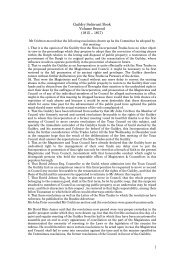Foreword I have just finished reading a book by the Rev. Jimmie ...
Foreword I have just finished reading a book by the Rev. Jimmie ...
Foreword I have just finished reading a book by the Rev. Jimmie ...
You also want an ePaper? Increase the reach of your titles
YUMPU automatically turns print PDFs into web optimized ePapers that Google loves.
Our instructors were Kenneth MacGregor a tall imposing official with G. C. Taylor <strong>the</strong> bag<br />
manufacturer in Alexander Street, Peter Marr from <strong>the</strong> 6th Lochee and a Mr. Gowans. The first half of <strong>the</strong><br />
evening was chanter practise and <strong>the</strong>n <strong>the</strong> o<strong>the</strong>r half was for pipes<br />
After you learn <strong>the</strong> scales you go on to your first tune, usually Highland Laddie <strong>the</strong>n Ho' Ro My<br />
Nut Brown Maiden.<br />
By now my fa<strong>the</strong>r was looking around for a set of bagpipes. At last he bought a set for £10. They<br />
were half silver mounted with a Black Watch tartan bag and tartan ribbons. The chanter had a unique feature<br />
in that <strong>the</strong> mouthpiece trap was usually made from <strong>the</strong> tongue lea<strong>the</strong>r of a shoe. Mine had a brass metal<br />
device. You had to learn <strong>the</strong> knack of pushing <strong>the</strong> slide up to stop <strong>the</strong> air exiting, o<strong>the</strong>rwise <strong>the</strong> air came<br />
back up <strong>the</strong> mouthpiece. It was done <strong>by</strong> a sharp push of <strong>the</strong> elbows into <strong>the</strong> bag immediately after <strong>the</strong> blow<br />
in.<br />
For beginners it is not easy, but once you master <strong>the</strong> knack, but this took quite a time, you could<br />
keep <strong>the</strong> bag filled with small puffs from your cheeks and concentrate on playing <strong>the</strong> chanter part.<br />
Learning to tune <strong>the</strong> three drones also took time and your ear did <strong>the</strong> rest. Each drone in turn must<br />
be ad<strong>just</strong>ed up or down, first <strong>the</strong> wee one <strong>the</strong>n <strong>the</strong> middle and finally <strong>the</strong> big drone. Then all three must be in<br />
unison - you should try it sometime.<br />
Anyway I got my pipers badge after two years and played with <strong>the</strong> Battalion Band at Baxter Park<br />
Parades and was once in <strong>the</strong> band along with <strong>the</strong> guard of honour at Belmont for <strong>the</strong> visit of <strong>the</strong> Queen<br />
Mo<strong>the</strong>r.<br />
I kept on playing for years. When I reached <strong>the</strong> age of leaving <strong>the</strong> Boys Brigade, I was invited to<br />
become a Warrant Officer and one of my main assets for <strong>the</strong> job was to start a pipe band in <strong>the</strong> 18th BB.<br />
Company.<br />
Soon I had eight pipers, two side drummers and a big drummer. One of <strong>the</strong> lads who put his name<br />
down at <strong>the</strong> start of a session was „wee Syd. Eggo‟ who in <strong>the</strong> words of most officers, was a pain in <strong>the</strong><br />
neck. Even <strong>the</strong> skipper, now Captain Laskie said “Harry you are wasting your time he never sticks at<br />
anything” and I still took him into <strong>the</strong> class. He was a fantastic pupil. He did his practises at home - he loved<br />
<strong>the</strong> instrument and was still playing when he became <strong>the</strong> age to leave <strong>the</strong> BB. He kept <strong>the</strong> bagpipes and I<br />
heard he was still playing in <strong>the</strong> Army. Well done Syd - I'm glad I had faith in you.<br />
FIRST AID<br />
I suppose I put my name down for this because I liked <strong>the</strong> badge. It was a metal shield with a red<br />
cross on it. That was after two years training <strong>the</strong>n a blue felt backing for three years and a red felt back for<br />
<strong>the</strong> 4th year.<br />
In first year, <strong>the</strong> triangular bandage was in great use, for various slings ei<strong>the</strong>r full out or folded<br />
into narrow or broad-fold. We learnt to use it for scalp wounds, broken shoulder blade or blades when we<br />
used two and tied at <strong>the</strong> back, broken ribs, which is not used today. Then <strong>the</strong> legs and last a broken femur<br />
using splints, <strong>the</strong> inner one up to <strong>the</strong> crutch and <strong>the</strong> outside one up to near <strong>the</strong> armpits using eight bandages.<br />
It was fun but every boy should learn this craft.<br />
Over <strong>the</strong> four years we learnt about <strong>the</strong> arteries and <strong>the</strong> veins, about poisons and <strong>the</strong>ir treatment. I<br />
never felt any of this was a waste of time, because in life I <strong>have</strong> on many occasions when knowing first aid<br />
saved a life. At 16 years old I was working in Cairds‟ Mill when I came across a mechanic, George Benton<br />
who had fallen down stairs, knocked himself out and was lying on his back, blood bubbling out of his<br />
6


